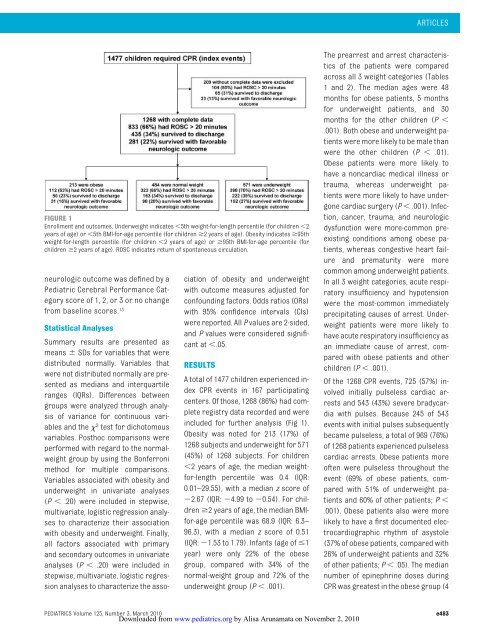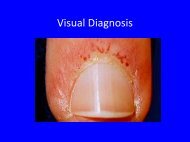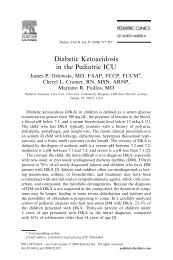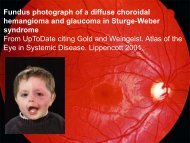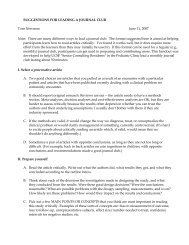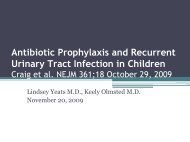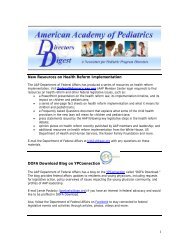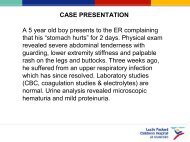DOI: 10.1542/peds.2009-1324 2010;125;e481-e488; originally ...
DOI: 10.1542/peds.2009-1324 2010;125;e481-e488; originally ...
DOI: 10.1542/peds.2009-1324 2010;125;e481-e488; originally ...
Create successful ePaper yourself
Turn your PDF publications into a flip-book with our unique Google optimized e-Paper software.
FIGURE 1<br />
Enrollment and outcomes. Underweight indicates 5th weight-for-length percentile (for children 2<br />
years of age) or 5th BMI-for-age percentile (for children 2 years of age). Obesity indicates 95th<br />
weight-for-length percentile (for children 2 years of age) or 95th BMI-for-age percentile (for<br />
children 2 years of age). ROSC indicates return of spontaneous circulation.<br />
neurologic outcome was defined by a<br />
Pediatric Cerebral Performance Category<br />
score of 1, 2, or 3 or no change<br />
from baseline scores. 13<br />
Statistical Analyses<br />
Summary results are presented as<br />
means SDs for variables that were<br />
distributed normally. Variables that<br />
were not distributed normally are presented<br />
as medians and interquartile<br />
ranges (IQRs). Differences between<br />
groups were analyzed through analysis<br />
of variance for continuous variables<br />
and the 2 test for dichotomous<br />
variables. Posthoc comparisons were<br />
performed with regard to the normalweight<br />
group by using the Bonferroni<br />
method for multiple comparisons.<br />
Variables associated with obesity and<br />
underweight in univariate analyses<br />
(P .20) were included in stepwise,<br />
multivariate, logistic regression analyses<br />
to characterize their association<br />
with obesity and underweight. Finally,<br />
all factors associated with primary<br />
and secondary outcomes in univariate<br />
analyses (P .20) were included in<br />
stepwise, multivariate, logistic regression<br />
analyses to characterize the asso-<br />
ciation of obesity and underweight<br />
with outcome measures adjusted for<br />
confounding factors. Odds ratios (ORs)<br />
with 95% confidence intervals (CIs)<br />
were reported. All P values are 2-sided,<br />
and P values were considered significant<br />
at .05.<br />
RESULTS<br />
A total of 1477 children experienced index<br />
CPR events in 167 participating<br />
centers. Of those, 1268 (86%) had complete<br />
registry data recorded and were<br />
included for further analysis (Fig 1).<br />
Obesity was noted for 213 (17%) of<br />
1268 subjects and underweight for 571<br />
(45%) of 1268 subjects. For children<br />
2 years of age, the median weightfor-length<br />
percentile was 0.4 (IQR:<br />
0.01–29.55), with a median z score of<br />
2.67 (IQR: 4.99 to 0.54). For children<br />
2 years of age, the median BMIfor-age<br />
percentile was 68.9 (IQR: 6.3–<br />
96.3), with a median z score of 0.51<br />
(IQR: 1.53 to 1.79). Infants (age of 1<br />
year) were only 22% of the obese<br />
group, compared with 34% of the<br />
normal-weight group and 72% of the<br />
underweight group (P .001).<br />
ARTICLES<br />
The prearrest and arrest characteristics<br />
of the patients were compared<br />
across all 3 weight categories (Tables<br />
1 and 2). The median ages were 48<br />
months for obese patients, 5 months<br />
for underweight patients, and 30<br />
months for the other children (P <br />
.001). Both obese and underweight patients<br />
were more likely to be male than<br />
were the other children (P .01).<br />
Obese patients were more likely to<br />
have a noncardiac medical illness or<br />
trauma, whereas underweight patients<br />
were more likely to have undergone<br />
cardiac surgery (P .001). Infection,<br />
cancer, trauma, and neurologic<br />
dysfunction were more-common preexisting<br />
conditions among obese patients,<br />
whereas congestive heart failure<br />
and prematurity were more<br />
common among underweight patients.<br />
In all 3 weight categories, acute respiratory<br />
insufficiency and hypotension<br />
were the most-common immediately<br />
precipitating causes of arrest. Underweight<br />
patients were more likely to<br />
have acute respiratory insufficiency as<br />
an immediate cause of arrest, compared<br />
with obese patients and other<br />
children (P .001).<br />
Of the 1268 CPR events, 725 (57%) involved<br />
initially pulseless cardiac arrests<br />
and 543 (43%) severe bradycardia<br />
with pulses. Because 245 of 543<br />
events with initial pulses subsequently<br />
became pulseless, a total of 969 (76%)<br />
of 1268 patients experienced pulseless<br />
cardiac arrests. Obese patients more<br />
often were pulseless throughout the<br />
event (69% of obese patients, compared<br />
with 51% of underweight patients<br />
and 60% of other patients; P <br />
.001). Obese patients also were more<br />
likely to have a first documented electrocardiographic<br />
rhythm of asystole<br />
(37% of obese patients, compared with<br />
26% of underweight patients and 32%<br />
of other patients; P .05). The median<br />
number of epinephrine doses during<br />
CPR was greatest in the obese group (4<br />
PEDIATRICS Volume <strong>125</strong>, Number 3, March <strong>2010</strong> e483<br />
Downloaded from<br />
www.pediatrics.org by Alisa Arunamata on November 2, <strong>2010</strong>


